Abstract
We examined nonopsonic binding of Mycobacterium avium-Mycobacterium intracellulare (MAI) by human leukocytes. Macrophages (M phi) avidly bound fluorescently labeled MAI in the absence of serum proteins. Binding appeared to be mediated by a lineage-specific, proteinaceous receptor on M phi, since (i) binding of labeled bacteria could be competitively inhibited by unlabeled MAI, (ii) treatment of M phi with trypsin ablated the ability of M phi to bind MAI, and (iii) the capacity to bind MAI was observed on monocytes, M phi, and stimulated polymorphonuclear cells but not on lymphocytes or unstimulated polymorphonuclear cells. The receptor for MAI appeared mobile in the plane of the membrane, since spreading of M phi on a carpet of immobilized, unlabeled MAI down modulated binding of labeled MAI added in suspension. The receptor required neither calcium nor magnesium for activity and appeared different from other known receptors for intracellular pathogens.
Full text
PDF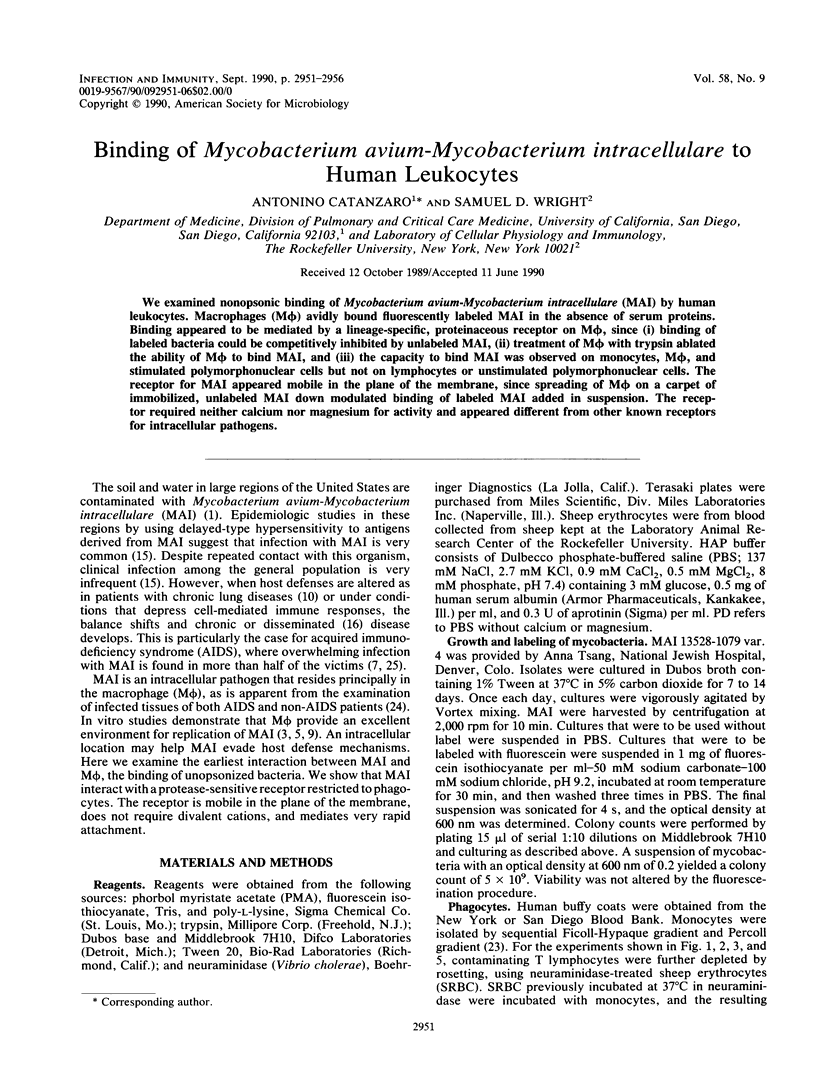
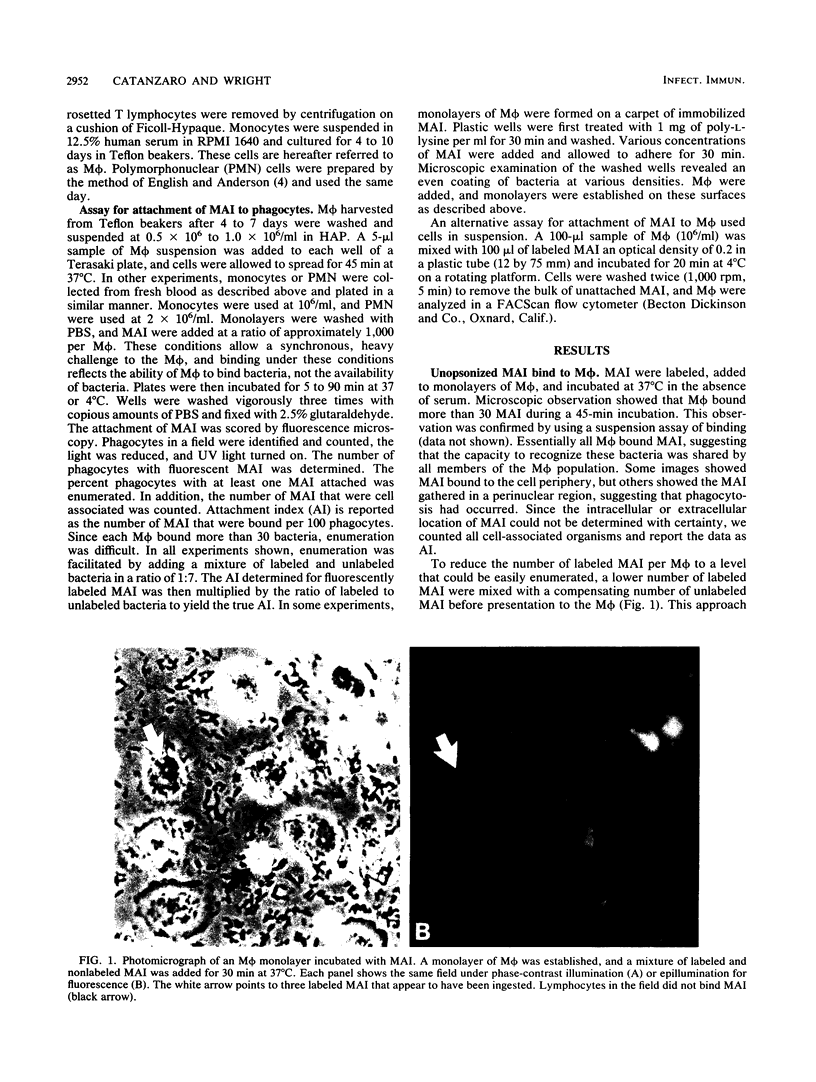
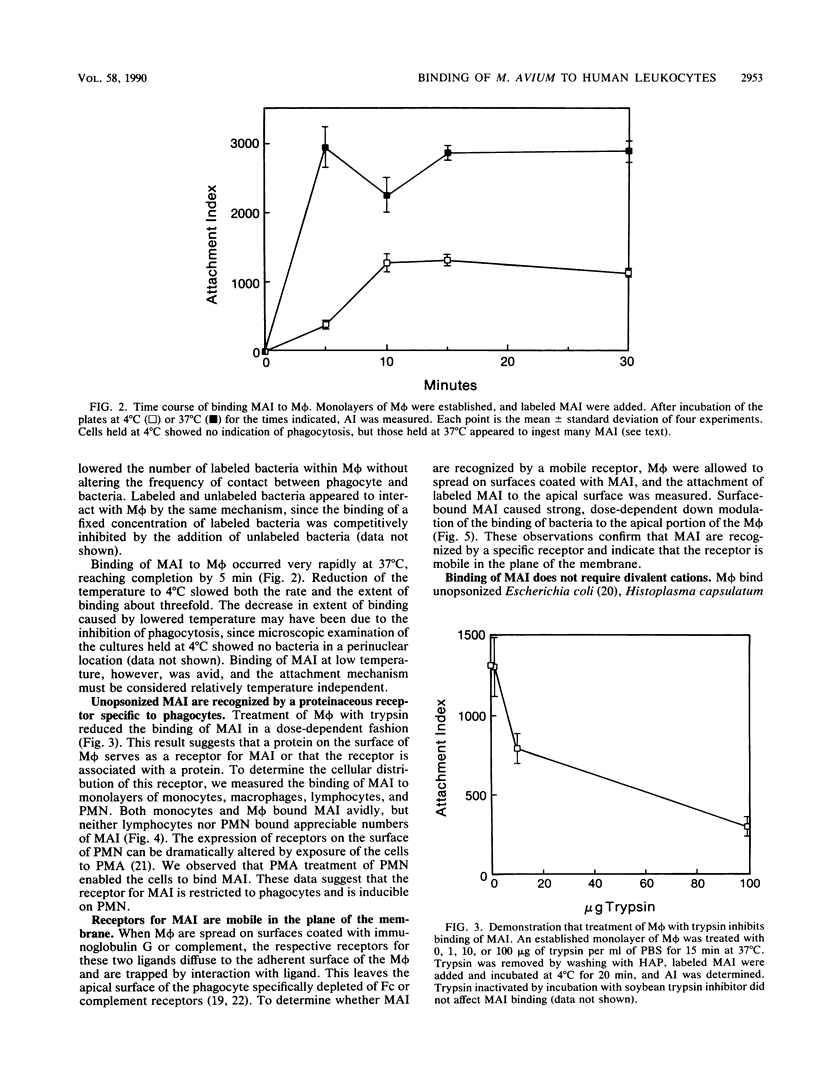
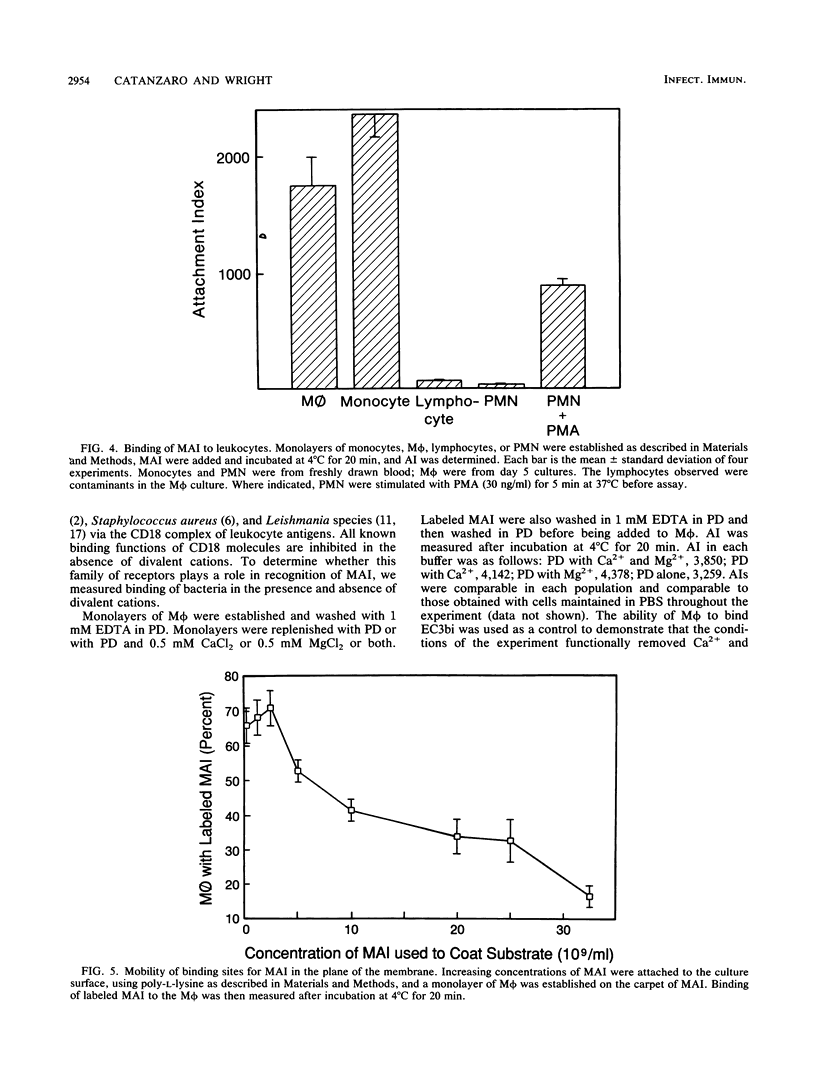
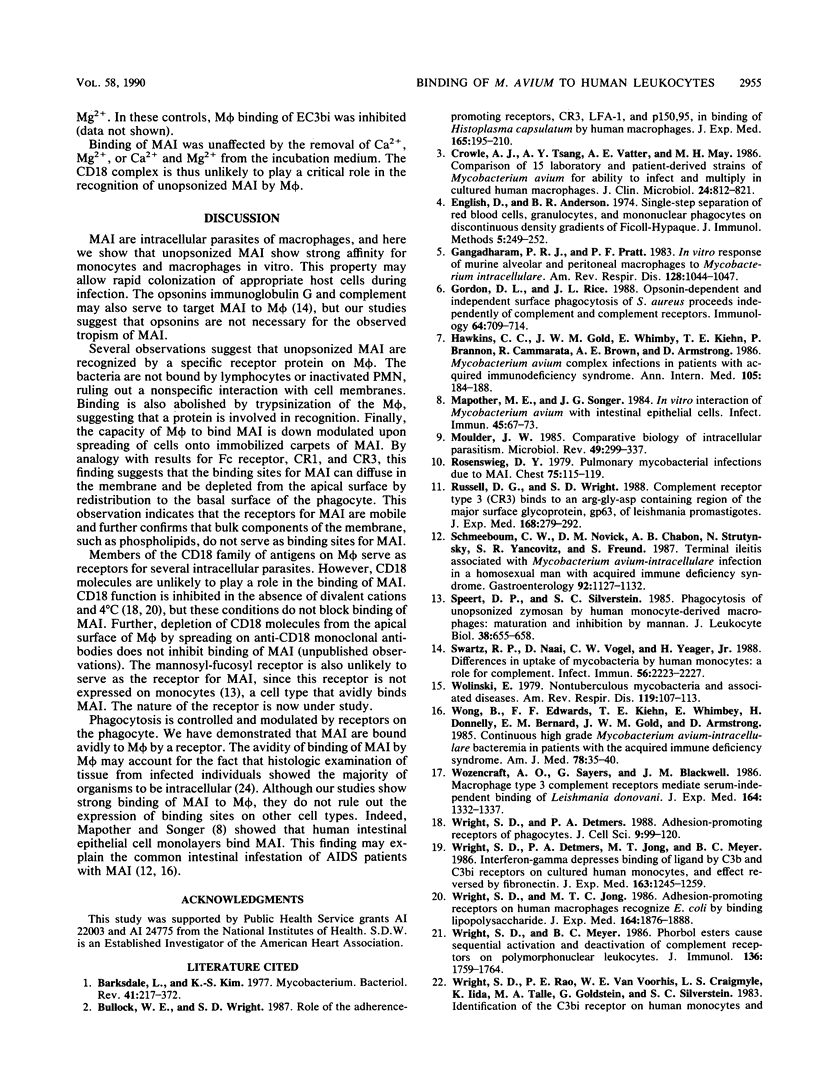
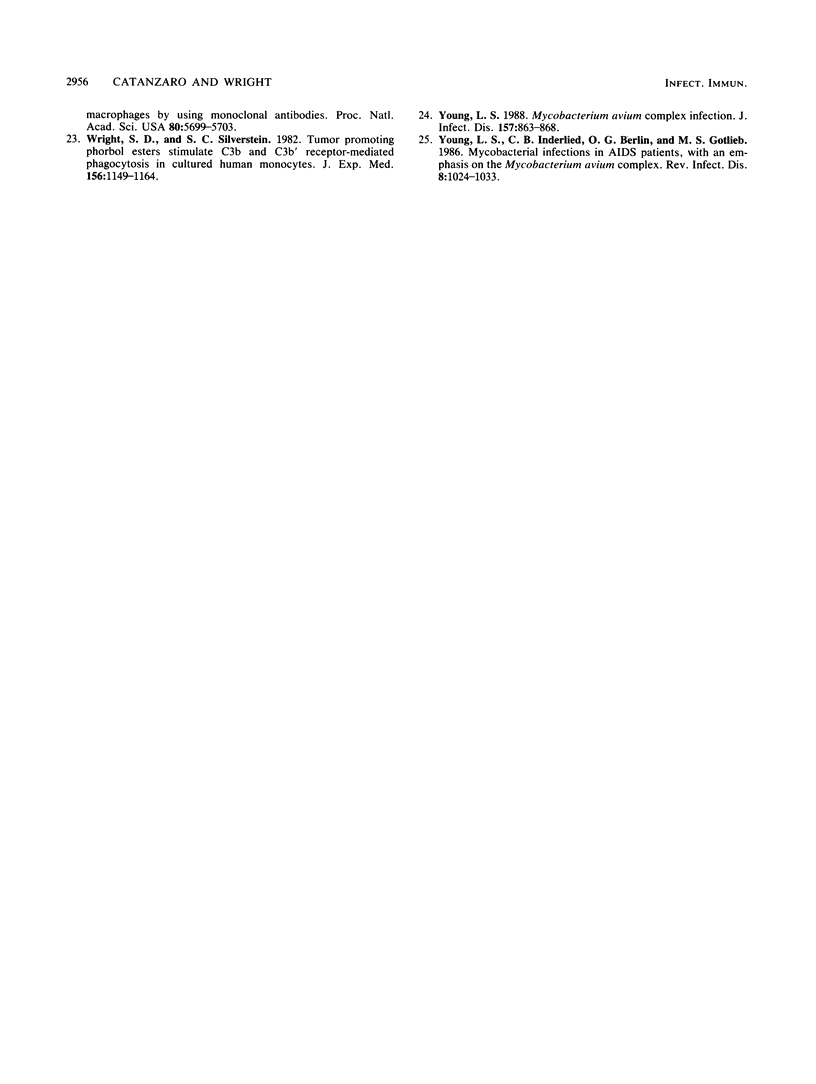
Images in this article
Selected References
These references are in PubMed. This may not be the complete list of references from this article.
- Barksdale L., Kim K. S. Mycobacterium. Bacteriol Rev. 1977 Mar;41(1):217–372. doi: 10.1128/br.41.1.217-372.1977. [DOI] [PMC free article] [PubMed] [Google Scholar]
- Bullock W. E., Wright S. D. Role of the adherence-promoting receptors, CR3, LFA-1, and p150,95, in binding of Histoplasma capsulatum by human macrophages. J Exp Med. 1987 Jan 1;165(1):195–210. doi: 10.1084/jem.165.1.195. [DOI] [PMC free article] [PubMed] [Google Scholar]
- Crowle A. J., Tsang A. Y., Vatter A. E., May M. H. Comparison of 15 laboratory and patient-derived strains of Mycobacterium avium for ability to infect and multiply in cultured human macrophages. J Clin Microbiol. 1986 Nov;24(5):812–821. doi: 10.1128/jcm.24.5.812-821.1986. [DOI] [PMC free article] [PubMed] [Google Scholar]
- English D., Andersen B. R. Single-step separation of red blood cells. Granulocytes and mononuclear leukocytes on discontinuous density gradients of Ficoll-Hypaque. J Immunol Methods. 1974 Aug;5(3):249–252. doi: 10.1016/0022-1759(74)90109-4. [DOI] [PubMed] [Google Scholar]
- Gangadharam P. R., Pratt P. F. In vitro response of murine alveolar and peritoneal macrophages to Mycobacterium intracellulare. Am Rev Respir Dis. 1983 Dec;128(6):1044–1047. doi: 10.1164/arrd.1983.128.6.1044. [DOI] [PubMed] [Google Scholar]
- Gordon D. L., Rice J. L. Opsonin-dependent and independent surface phagocytosis of S. aureus proceeds independently of complement and complement receptors. Immunology. 1988 Aug;64(4):709–714. [PMC free article] [PubMed] [Google Scholar]
- Hawkins C. C., Gold J. W., Whimbey E., Kiehn T. E., Brannon P., Cammarata R., Brown A. E., Armstrong D. Mycobacterium avium complex infections in patients with the acquired immunodeficiency syndrome. Ann Intern Med. 1986 Aug;105(2):184–188. doi: 10.7326/0003-4819-105-2-184. [DOI] [PubMed] [Google Scholar]
- Mapother M. E., Songer J. G. In vitro interaction of Mycobacterium avium with intestinal epithelial cells. Infect Immun. 1984 Jul;45(1):67–73. doi: 10.1128/iai.45.1.67-73.1984. [DOI] [PMC free article] [PubMed] [Google Scholar]
- Moulder J. W. Comparative biology of intracellular parasitism. Microbiol Rev. 1985 Sep;49(3):298–337. doi: 10.1128/mr.49.3.298-337.1985. [DOI] [PMC free article] [PubMed] [Google Scholar]
- Rosenzweig D. Y. Pulmonary mycobacterial infections due to Mycobacterium intracellulare-avium complex. Clinical features and course in 100 consecutive cases. Chest. 1979 Feb;75(2):115–119. doi: 10.1378/chest.75.2.115. [DOI] [PubMed] [Google Scholar]
- Russell D. G., Wright S. D. Complement receptor type 3 (CR3) binds to an Arg-Gly-Asp-containing region of the major surface glycoprotein, gp63, of Leishmania promastigotes. J Exp Med. 1988 Jul 1;168(1):279–292. doi: 10.1084/jem.168.1.279. [DOI] [PMC free article] [PubMed] [Google Scholar]
- Schneebaum C. W., Novick D. M., Chabon A. B., Strutynsky N., Yancovitz S. R., Freund S. Terminal ileitis associated with Mycobacterium avium-intracellulare infection in a homosexual man with acquired immune deficiency syndrome. Gastroenterology. 1987 May;92(5 Pt 1):1127–1132. doi: 10.1016/s0016-5085(87)91068-7. [DOI] [PubMed] [Google Scholar]
- Speert D. P., Silverstein S. C. Phagocytosis of unopsonized zymosan by human monocyte-derived macrophages: maturation and inhibition by mannan. J Leukoc Biol. 1985 Nov;38(5):655–658. doi: 10.1002/jlb.38.5.655. [DOI] [PubMed] [Google Scholar]
- Swartz R. P., Naai D., Vogel C. W., Yeager H., Jr Differences in uptake of mycobacteria by human monocytes: a role for complement. Infect Immun. 1988 Sep;56(9):2223–2227. doi: 10.1128/iai.56.9.2223-2227.1988. [DOI] [PMC free article] [PubMed] [Google Scholar]
- Wong B., Edwards F. F., Kiehn T. E., Whimbey E., Donnelly H., Bernard E. M., Gold J. W., Armstrong D. Continuous high-grade mycobacterium avium-intracellulare bacteremia in patients with the acquired immune deficiency syndrome. Am J Med. 1985 Jan;78(1):35–40. doi: 10.1016/0002-9343(85)90458-9. [DOI] [PubMed] [Google Scholar]
- Wozencraft A. O., Sayers G., Blackwell J. M. Macrophage type 3 complement receptors mediate serum-independent binding of Leishmania donovani. Detection of macrophage-derived complement on the parasite surface by immunoelectron microscopy. J Exp Med. 1986 Oct 1;164(4):1332–1337. doi: 10.1084/jem.164.4.1332. [DOI] [PMC free article] [PubMed] [Google Scholar]
- Wright S. D., Detmers P. A. Adhesion-promoting receptors on phagocytes. J Cell Sci Suppl. 1988;9:99–120. doi: 10.1242/jcs.1988.supplement_9.5. [DOI] [PubMed] [Google Scholar]
- Wright S. D., Detmers P. A., Jong M. T., Meyer B. C. Interferon-gamma depresses binding of ligand by C3b and C3bi receptors on cultured human monocytes, an effect reversed by fibronectin. J Exp Med. 1986 May 1;163(5):1245–1259. doi: 10.1084/jem.163.5.1245. [DOI] [PMC free article] [PubMed] [Google Scholar]
- Wright S. D., Jong M. T. Adhesion-promoting receptors on human macrophages recognize Escherichia coli by binding to lipopolysaccharide. J Exp Med. 1986 Dec 1;164(6):1876–1888. doi: 10.1084/jem.164.6.1876. [DOI] [PMC free article] [PubMed] [Google Scholar]
- Wright S. D., Meyer B. C. Phorbol esters cause sequential activation and deactivation of complement receptors on polymorphonuclear leukocytes. J Immunol. 1986 Mar 1;136(5):1759–1764. [PubMed] [Google Scholar]
- Wright S. D., Rao P. E., Van Voorhis W. C., Craigmyle L. S., Iida K., Talle M. A., Westberg E. F., Goldstein G., Silverstein S. C. Identification of the C3bi receptor of human monocytes and macrophages by using monoclonal antibodies. Proc Natl Acad Sci U S A. 1983 Sep;80(18):5699–5703. doi: 10.1073/pnas.80.18.5699. [DOI] [PMC free article] [PubMed] [Google Scholar]
- Wright S. D., Silverstein S. C. Tumor-promoting phorbol esters stimulate C3b and C3b' receptor-mediated phagocytosis in cultured human monocytes. J Exp Med. 1982 Oct 1;156(4):1149–1164. doi: 10.1084/jem.156.4.1149. [DOI] [PMC free article] [PubMed] [Google Scholar]
- Young L. S., Inderlied C. B., Berlin O. G., Gottlieb M. S. Mycobacterial infections in AIDS patients, with an emphasis on the Mycobacterium avium complex. Rev Infect Dis. 1986 Nov-Dec;8(6):1024–1033. doi: 10.1093/clinids/8.6.1024. [DOI] [PubMed] [Google Scholar]
- Young L. S. Mycobacterium avium complex infection. J Infect Dis. 1988 May;157(5):863–867. doi: 10.1093/infdis/157.5.863. [DOI] [PubMed] [Google Scholar]



